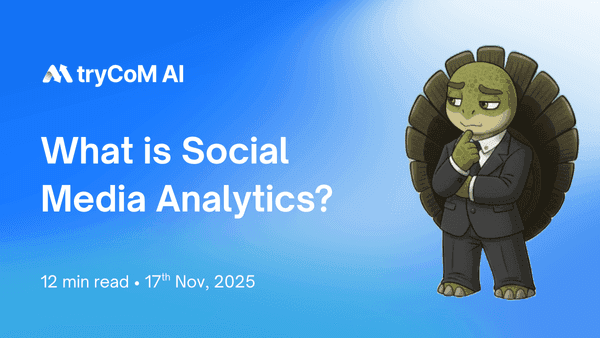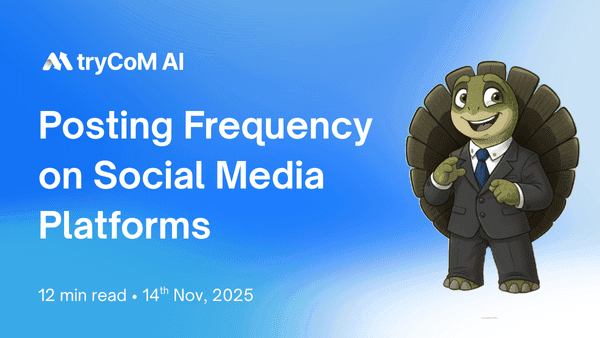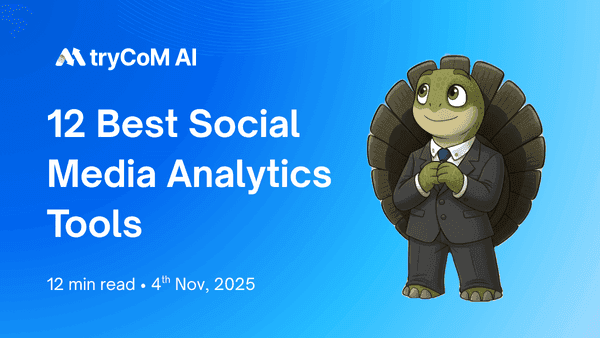What is Social Media Analytics ? The Complete Guide
This comprehensive guide to social media analytics explains how brands can use data, metrics, and AI-powered insights to optimize performance across platforms like Instagram, Facebook, YouTube, LinkedIn, and TikTok. It covers key metrics, tools, strategies, pricing comparisons, and emerging trends for 2025 to help businesses make smarter, data-driven decisions. Whether you're a marketer, business owner, or analyst, this blog provides everything needed to build a strong, insight-led social media strategy.

Quick Summary
- Social media analytics helps brands collect, analyze, and interpret data from platforms like Instagram, Facebook, LinkedIn, YouTube, TikTok, and X.
- It enables businesses to understand audience behavior, improve content performance, track ROI, and monitor brand sentiment in real time.
- Modern analytics uses AI, NLP, and predictive modeling to uncover trends, detect crises early, and optimize marketing decisions.
- Key metrics include engagement rate, reach, impressions, audience growth, watch time, sentiment score, and share of voice.
- Tools like tryCoM, Sprout Social, Hootsuite, Brandwatch, and native platform analytics offer dashboards, competitor insights, and automated reporting.
- Pricing varies widely depending on features, ranging from affordable SMB tools to enterprise-level AI-powered platforms.
- Social media analytics is essential in 2025 for data-driven strategies, competitive advantage, and building meaningful customer relationships.
Introduction
In a world where social media drives brand reputation, customer sentiment, and purchase decisions, social media analytics has become a core pillar of digital strategy. Businesses today generate massive amounts of social data — likes, comments, shares, mentions, stories, reels, reviews, and conversations. But data alone is not enough. What matters is the ability to interpret, predict, and act on that data. Social media analytics helps organizations transform scattered social interactions into actionable insights, enabling better decision-making across marketing, customer support, product development, and brand management.
Why It Matters in 2025
- Platforms are shifting toward AI-driven recommendations, making analytics more important for visibility.
- Consumers expect brands to respond faster and more authentically.
- Businesses face increased competition, requiring smarter decisions backed by data.
Social media analytics has evolved from simple metrics (likes/followers) into a complete intelligence system that helps brands stay competitive, informed, and customer-centric.
How Social Media Analytics Works
The analytics process typically moves through three major layers:
A. Data Collection
Tools collect data from:
- Public APIs (Instagram, Facebook, YouTube, X, TikTok)
- Brand-owned channels (comments, messages, ads)
- Web and social crawlers (reviews, blogs, mentions)
B. Data Processing
Collected data is cleaned, categorized, and analyzed using:
- NLP (Natural Language Processing)
- Machine learning
- Sentiment analysis
- Topic modeling
- Trend prediction
C. Visualization & Reporting
Dashboards transform raw data into:
- Trends
- Graphs
- Performance comparisons
- Predictive insights
- Alerts for brand mentions or crises
Key Concepts
| Concept | Description |
|---|---|
| Social Monitoring | Tracks notifications, messages, and direct interactions. |
| Social Listening | Tracks conversations, trends, and public sentiment across platforms. |
| Social Intelligence | Advanced insights combining analytics + customer behavior + market signals. |
Together, these layers create a powerful system that helps businesses decode audience behavior and optimize strategy.
Core Benefits of Social Media Analytics
Social media analytics delivers business value far beyond marketing. Some core benefits include:
Improved Brand Awareness: Identify which content performs best, which demographics engage more, and what drives virality.
Stronger Content Strategy
Analytics helps identify:
- Ideal posting times
- Best-performing content types
- Formats that generate maximum engagement (reels, carousels, shorts)
Better Audience Understanding
Discover patterns in:
- Age
- Location
- Interests
- Sentiment
- Buying intent
Crisis & Reputation Management
Real-time alerts help brands respond to:
- Negative reviews
- Viral complaints
- Industry controversies
- Competitor attacks
Competitive Benchmarking: Analytics shows how your performance compares to competitors.
Improved ROI: Optimizing ad spend, targeting, and campaign messaging becomes easier with insights.
Types of Social Media Analytics
Analytics is not just about tracking numbers — it’s about analyzing the “why” behind them. The four main types include:
A. Descriptive Analytics (What Happened?)
Example:
“Your reel reached 1M viewers last week.”
B. Diagnostic Analytics (Why Did It Happen?)
Example:
“Reach increased due to trending audio and peak-time posting.”
C. Predictive Analytics (What Will Happen?)
Example:
“Your engagement is projected to grow 20% this month.”
D. Prescriptive Analytics (What Should You Do Next?)
Example:
“Post more reels using educational topics and trending hashtags.”
Other Key Analytical Types
| Type | Purpose | Example |
|---|---|---|
| Sentiment Analysis | Understand emotions and tone | Positive vs negative brand mentions |
| Influencer Analytics | Track influencer performance | Engagement vs cost |
| Competitor Analytics | Compare with competitor brands | Share of Voice |
| Customer Journey Analytics | Track customer touchpoints | From awareness → conversion |
Key Social Media Metrics & KPIs
Not all metrics matter equally. Here are the most important KPIs brands should track:
Engagement Metrics
- Likes
- Comments
- Shares
- Saves
- Clicks
- Sticker taps
Reach & Impressions: Shows how many people saw your content.
Follower Growth Rate: Indicates brand momentum.
Video Analytics
- Watch time
- Average view duration
- Retention rate
Conversion Metrics
- Leads
- Purchases
- Registrations
- Website visits
Sentiment Metrics: Helps understand customer mood.
Share of Voice: Measures brand visibility compared to competitors.
Cost Metrics
- CPC
- CPM
- CPA
- ROAS
Sample KPI Table:
| Category | KPI | Why It Matters |
|---|---|---|
| Engagement | ER% | Indicates content strength |
| Awareness | Reach | Measures visibility |
| Conversion | CTR/CR | Measures funnel performance |
| Sentiment | CSAT/Sentiment Score | Measures brand health |
| Competitive | SOV | Measures market dominance |
Platform-Wise Analytics Breakdown
Each platform measures performance differently.
Instagram Analytics
In Instagram Analytics Track:
- Reach
- Saves
- Reel watch time
- Hashtag performance
- Audio trends
Facebook Analytics
Track:
- Page insights
- Link clicks
- Ad metrics
- Post reactions
LinkedIn Analytics
Track:
- Industry engagement
- Employee advocacy impact
- Profile visits
- Lead generation forms
YouTube Analytics
Track:
- Audience retention
- CTR
- Engagement levels
- Suggested video impressions
TikTok Analytics
Track:
- Traffic sources
- Rewatch rate
- Trending sounds
- Completion rate
Pinterest Analytics
Track:
- Outbound clicks
- Pin saves
- Monthly viewers
Twitter/X Analytics
Track:
- Tweet activity
- Profile visits
- Mention spikes
Social Media Analytics Tools: Categories & Examples
Native Tools
| Platform | Native Tool |
|---|---|
| Instagram Insights | |
| Meta Business Suite | |
| YouTube | YouTube Studio |
| Linkedin Page Analytics | |
| TikTok | TikTok Creator Analytics |
Third-Party Tools
| Category | Tools |
|---|---|
| All-in-one | tryCoM, Sprout Social, Hootsuite, Zoho Social |
| Listening + AI | Sprinklr, Brandwatch |
| Customer Experience | Qualtrics XM |
Enterprise Features
- Multi-channel dashboards
- Predictive insights
- Team workflows
- AI-powered alerts
Core Functions of Social Media Analytics Tools
- Unified dashboards
- Social listening
- Competitor tracking
- Influencer mapping
- Customer care analytics
- Paid + organic analytics
- Automated reporting
- AI recommendations
Pricing Comparison of Top Tools (2025)
| Tool | Monthly Price | Best For | Key Features |
|---|---|---|---|
| tryCoMl | $96 | Agencies and Businesses | Analytics, reporting, CRM |
| Sprout Social | $199 | Large teams | Listening, reporting, CRM |
| Hootsuite | $23 | SMBs | Scheduling, monitoring |
| Buffer | $5 | Individuals/SMBs | Publishing, insights |
| Zoho Social | $7 | Budget users | Scheduling, analytics |
This section helps users choose based on budget, scale, and requirements.
How to Choose the Right Social Media Analytics Tool
Before selecting a tool, evaluate:
- Your goals (brand, leads, engagement, support)
- Team size
- Budget
- Required features (AI, listening, reporting)
- Integration needs
- Customer care requirements
- Scalability
Challenges in Social Media Analytics
| Challenge | Description |
|---|---|
| Data Accuracy | Sentiment models are not 100% perfect |
| API Limitations | Platforms limit data access |
| Measuring ROI | Hard to attribute conversions fully |
| Privacy Rules | Increasing compliance requirements |
| Cross-Platform Tracking | Each platform uses different metrics |
Emerging Trends in Social Media Analytics for 2025
AI-Driven Predictive Insights
Tools now forecast:
- Engagement
- Reach
- Virality probability
Real-Time Sentiment Mapping: Get emotional insights within seconds of a post going live.
Generative AI Insights
Platforms like Sprinklr and Hootsuite are integrating AI to:
- Summarize reports
- Suggest content ideas
- Recommend optimizations
First-Party Data Shift: Brands rely more on CRM + social integration for deeper insights.
Conclusion
Social media analytics is no longer optional — it is a strategic advantage. Brands that leverage analytics effectively gain deeper audience insights, optimize their content strategy, react to trends faster, and ultimately achieve higher ROI. As platforms evolve and AI becomes central to analytics, businesses must invest in the right tools and practices to stay ahead.
With the right strategy, social media analytics becomes not just a data process — but a growth engine for your brand.
Frequently Asked Questions (FAQs)
1. What is social media analytics?
Social media analytics refers to collecting and analyzing data from social media platforms to understand audience behavior, brand performance, and campaign impact. It helps businesses make informed decisions based on trends, sentiment, and engagement metrics.
2. Why is social media analytics important for businesses?
It helps brands measure what’s working, find growth opportunities, and optimize content strategies. With real-time insights, businesses can improve engagement, react to customer concerns, and maximize ROI across marketing channels.
3. What are the most important metrics to track?
Key metrics include engagement rate, reach, impressions, click-through rate, sentiment score, and follower growth. These metrics reveal how well your content resonates and how effectively your brand is building visibility.
4. What tools are best for social media analytics?
Popular options include Sprout Social, Hootsuite, Sprinklr, Brandwatch, Zoho Social, and native tools like Instagram Insights and YouTube Studio. The right tool depends on your budget, business size, and need for features like listening, AI insights, or automated reporting.
5. How does AI improve social media analytics?
AI can predict trends, detect sentiment with high accuracy, and suggest the best content formats and posting times. It also automates reporting and identifies patterns humans may overlook.
6. Is social media analytics different from social listening?
Yes. Social listening tracks conversations, mentions, and sentiment across the internet, while analytics focuses on measuring performance and metrics from your own channels. Together, they provide a complete understanding of brand perception and audience behavior.

Annamalai Kathir (AK)
Annamalai Kathir (https://www.linkedin.com/in/annamalai-kathirkamanathan/) - Marketing Analytics & AI MarTech Expert. As tryCoM's CEO, he has dedicated his career to building AI tools that simplify marketing and performance optimization for startups, enterprise, and agencies. With 10+ years of expertise in SaaS product marketing, digital marketing, social media analytics, SEO/GEO optimization, and competitive intelligence, Annamalai leads the team in developing AI-powered marketing software that delivers social media listening, content automation, competitor analysis, and unified ROI measurement to help businesses and agencies achieve data-driven growth and measurable outcomes. Connect: https://akathir.github.io/ | https://www.instagram.com/akathirk/ | https://x.com/kathirannamalai
View profile →More blogs by Annamalai Kathir (AK)

Social Media Engagement Rate - Formulas, Benchmarks & Strategies (2025)
This comprehensive guide explains what engagement rate is, why it matters, and how to measure it using accurate formulas across followers, reach, impressions, and views. It covers benchmarks, platform-wise engagement behavior, tools like tryCoM, and proven strategies to improve engagement in 2025. Perfect for marketers, creators, and businesses looking to understand and grow their social media performance.

How Often to Post on Every Social Media Platform in 2025: Complete Frequency Guide
This complete guide explains how often to post on every major social media platform in 2025, with clear frequency benchmarks for Instagram, Facebook, LinkedIn, TikTok, YouTube, Pinterest, X, and Threads. It helps brands and creators find the perfect posting rhythm to maximize reach, engagement, and growth. Plus, it shows how tools like tryCoM can automate content creation and posting for consistent results.

12 Best Social Media Analytics Tools Every Marketer Needs in 2025
Discover the 12 best social media analytics tools for 2025 that help marketers track performance, measure ROI, and gain deep audience insights. Learn how tryCoM unifies Google and social analytics for smarter, data-driven decisions.